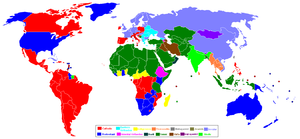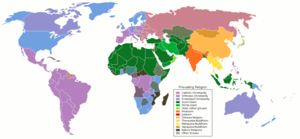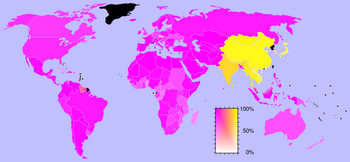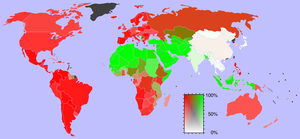Major religious groups
The world's principal religions and spiritual traditions may be classified into a small number of major groups, although this is by no means a uniform practice. This theory began in the 18th century with the goal of recognizing the relative levels of civility in non-European societies.[1] However, it quickly transformed into a subset of the universalist belief that all religious figures teach of a single, cross-cultural truth.
For a more comprehensive list of religions and an outline of some of their basic relationships, please see the article list of religions.
Contents |
History of religious categories
In world cultures, there have traditionally been many different groupings of religious belief. In Indian culture, different religious philosophies were traditionally respected as academic differences in pursuit of the same truth. In Islam, the Qur'an mentions three different categories: Muslims, the People of the Book, and idol worshipers. To some extent these theories of religiousness are still prevalent today. However, the most common classification today was birthed out of Western Christianity.
Initially, Christians had a simple dichotomy of world beliefs: Christian civility versus foreign heresy or barbarity. In the eighteenth century, "heresy" was clarified to mean Judaism and Islam; along with outright paganism, this created a fourfold classification which spawned such works as John Toland's Nazarenus, or Jewish, Gentile, and Mahometan Christianity, which represented the three Abrahamic traditions as different "nations" or sects within religion itself, the true monotheism. At the turn of the 18th century, in between 1780 and 1810, the language dramatically changed: instead of "religion" being synonymous with spirituality, authors began using the plural, "religions", to refer to both Christianity and other forms of worship. This new definition was described as follows by Daniel Defoe: "Religion is properly the Worship given to God, but 'tis also applied to the Worship of Idols and false Deities."[2]
In 1838, the four-way division of Christianity, Judaism, "Mahommedanism" and Paganism was multiplied considerably by Josiah Conder's Analytical and Comparative View of All Religions Now Extant among Mankind. Conder's work still adheres to the four-way classification, but in his eye for detail he puts together much historical work to create something resembling our modern Western image: he includes Druze, Yezidis, Mandeans, and Elamites under a list of possibly monotheistic groups, and under the final category, of "polytheism and pantheism", he lists Zoroastrianism, "Vedas, Puranas, Tantras, Reformed sects" of India as well as "Brahminical idolatry", Buddhism, Jainism, Sikhism, Lamaism, "religion of China and Japan", and "illiterate superstitions".[3]
Even through the late nineteenth century, it was common to view these "pagan" sects as dead traditions which preceded Christianity, the final, complete word of God. This in no way reflected the reality of religious experience: Christians supposed these traditions to have maintained themselves in an unchanging state since whenever they were "invented", but actually all traditions survived in the words and deeds of people, some of whom could make radical new inventions without needing to create a new sect. The biggest problem in this approach was the existence of Islam, a religion which had been "founded" after Christianity, and which had been experienced by Christians as intellectual and material prosperity. By the nineteenth century, however, it was possible to dismiss Islam as a revelation of "the letter, which killeth", given to savage desert nomads.[4] In this context, the term "world religion" referred only to Christianity, which Europeans considered uniquely posed to civilize the world.
The modern meaning of the phrase "world religion" began with the 1893 Parliament of the World's Religions in Chicago, Illinois. This event was sharply criticized by European Orientalists up until the 1960s as "unscientific", because it allowed religious leaders to speak for themselves instead of bowing to the superior knowledge of the Western academic. As a result its approach to "world religion" was not taken seriously in the scholarly world for some time. Nevertheless, the Parliament spurred the creation of a dozen privately funded lectures with the intent of informing people of the diversity of religious experience: these lectures funded researchers such as William James, D.T. Suzuki, and Alan Watts.[5]
In the latter half of the 20th century, the category of "world religion" fell into serious question, especially for drawing parallels between vastly different cultures, and thereby creating an arbitrary separation between the religious and the secular.[6] Even history professors have now taken note of these complications and advise against teaching "world religions" in schools.[7]
Western classification
Religious traditions fall into super-groups in comparative religion, arranged by historical origin and mutual influence. Abrahamic religions originate in the Middle East, Indian religions in India and Far Eastern religions in East Asia. Another group with supra-regional influence are African diasporic religions, which have their origins in Central and West Africa.
- Abrahamic religions are the largest group, and these consist mainly of Christianity, Islam, Judaism and Bahá'í Faith. They are named for the patriarch Abraham, and are unified by the practice of monotheism. Today, around 3.4 billion people are followers of Abrahamic religions and are spread widely around the world apart from the regions around South-East Asia. Several Abrahamic organizations are vigorous proselytizers.[8]
- Indian religions originated in Greater India and tend to share a number of key concepts, such as dharma and karma. They are of the most influence across the Indian subcontinent, East Asia, South East Asia, as well as isolated parts of Russia. The main Indian religions are Hinduism, Jainism, Buddhism and Sikhism. Indian religions mutually influenced each other. Sikhism was also influenced by the Abrahamic tradition of Sufism.
- East Asian religions consist of several East Asian religions which make use of the concept of Tao (in Chinese) or Do (in Japanese or Korean), namely Taoism and Confucianism, both of which are asserted by some scholars to be non-religious in nature.
- African diasporic religions practiced in the Americas, imported as a result of the Atlantic slave trade of the 16th to 18th centuries, building of traditional religions of Central and West Africa.
- Indigenous tribal religions, formerly found on every continent, now marginalized by the major organized faiths, but persisting as undercurrents of folk religion. Includes African traditional religions, Asian Shamanism, Native American religions, Austronesian and Australian Aboriginal traditions, Chinese folk religion, and postwar Shinto. Under more traditional listings, this has been referred to as "Paganism" along with historical polytheism.
- Iranic religions (not listed below due to overlaps) originated in Iran and include Zoroastrianism, Yazdanism, Ahl-e Haqq and historical traditions of Gnosticism (Mandaeanism, Manichaeism). It has significant overlaps with Abrahamic traditions, e.g. in Sufism and in recent movements such as Bábísm and the Bahá'í Faith.
- New religious movement is the term applied to any religious faith which has emerged since the 19th century, often syncretizing, re-interpreting or reviving aspects of older traditions: Hindu revivalism, Ayyavazhi, Pentecostalism, polytheistic reconstructionism, and so forth.
Religious demographics

One way to define a major religion is by the number of current adherents. The population numbers by religion are computed by a combination of census reports and population surveys (in countries where religion data is not collected in census, for example USA or France), but results can vary widely depending on the way questions are phrased, the definitions of religion used and the bias of the agencies or organizations conducting the survey. Informal or unorganized religions are especially difficult to count.
There is no consensus among researchers as to the best methodology for determining the religiosity profile of the world's population. A number of fundamental aspects are unresolved:
- Whether to count "historically predominant religious culture[s]"[9]
- Whether to count only those who actively "practice" a particular religion[10]
- Whether to count based on a concept of "adherence"[11]
- Whether to count only those who expressly self-identify with a particular denomination[12]
- Whether to count only adults, or to include children as well.
- Whether to rely only on official government-provided statistics[13]
- Whether to use multiple sources and ranges or single "best source(s)"
Largest religions or belief systems by number of adherents
The table below lists religions classified by philosophy; however, religious philosophy is not always the determining factor in local practice. Please note that this table includes heterodox movements as adherents to their larger philosophical category, although this may be disputed by others within that category. For example, Cao Đài is listed because it claims to be a separate category from Buddhism, while Hoa Hao is not, even though they are similar new religious movements.
The population numbers below are computed by a combination of census reports, random surveys (in countries where religion data is not collected in census, for example USA or France), and self-reported attendance numbers, but results can vary widely depending on the way questions are phrased, the definitions of religion used and the bias of the agencies or organizations conducting the survey. Informal or unorganized religions are especially difficult to count. Some organizations may wildly inflate their numbers.
By region
- Religion in Africa
- Religion in Asia
- Religion in India
- Religion in China
- Muslim world (SW Asia and N Africa)
- Religion in North America
- Religion in Canada
- Religion in Mexico
- Religion in the United States
- Religion in South America
- Religion in Australia
- Religion in Europe
- Religion in the European Union
Trends in adherence
Since the late 19th century, the demographics of religion have changed a great deal. Some countries with a historically large Christian population have experienced a significant decline in the numbers of professed active Christians: see demographics of atheism. Symptoms of the decline in active participation in Christian religious life include declining recruitment for the priesthood and monastic life, as well as diminishing attendance at church. On the other hand, since the 19th century, large areas of sub-saharan Africa have been converted to Christianity, and this area of the world has the highest population growth rate. In the realm of Western civilization, there has been an increase in the number of people who identify themselves as secular humanists. In many countries, such as the People's Republic of China, communist governments have discouraged religion, making it difficult to count the actual number of believers. However, after the collapse of communism in numerous countries of Eastern Europe and the former Soviet Union, religious life has been experiencing resurgence there, both in the form of traditional Eastern Christianity and particularly in the forms of Neopaganism and Far Eastern religions.
Following is some available data based on the work of the World Christian Encyclopedia:[45]
| 1970-1985[46] | 1990-2000[47][48] | 2000-2005[49] |
|---|---|---|
| 3.65% - Bahá'í Faith | 2.65% - Zoroastrianism | 1.84% - Islam |
| 2.74% - Islam | 2.28% - Bahá'í Faith | 1.70% - Bahá'í Faith |
| 2.34% - Hinduism | 2.13% - Islam | 1.62% - Sikhism |
| 1.67% - Buddhism | 1.87% - Sikhism | 1.57% - Hinduism |
| 1.64% - Christianity | 1.69% - Hinduism | 1.32% - Christianity |
| 1.09% - Judaism | 1.36% - Christianity | |
| 1.09% - Buddhism | ||
| The annual growth in the world population over the same period is 1.41%. |
Studies conducted by the Pew Research Center have found that, generally, poorer nations had a larger proportion of citizens who found religion to be very important than richer nations, with the exceptions of the United States[50] and Kuwait.[51]
Maps of self-reported adherence
|
Map showing relative degree of religiosity by country. Based on a 2006-2008 worldwide survey by Gallup. |
 World map showing the percentages of people who regard religion as "non-important" according to a 2002 Pew survey |
 Religions of the world, mapped by distribution. |
 Predominant religions of the world, mapped by state |
 Map showing the prevalence of "Abrahamic religion" (purple), and "Indian religion" (yellow) religions in each country. |
 Map showing the relative proportion of Christianity (red) and Islam (green) in each country. |
See also
- Claims to be the fastest growing religion
- Category:Religion by country
- List of religions
- Religious text
- Religious conversion
- List of religious populations
References
- ↑ Masuzawa, Tomoko (2005). The Invention of World Religions. Chicago University of Chicago Press. ISBN 978-0226509891.
- ↑ Masuzawa 2005. pp. 49-61
- ↑ Masuzawa 2005, 65-6
- ↑ Masuzawa 2005, 82-3
- ↑ Masuzawa 2005, 270-281
- ↑ Stephen R. L. Clark. "World Religions and World Orders". Religious Studies 26.1 (1990).
- ↑ Joel E. Tishken. "Ethnic vs. Evangelical Religions: Beyond Teaching the World Religion Approach". The History Teacher 33.3 (2000).
- ↑ Brodd, Jefferey (2003). World Religions. Winona, MN: Saint Mary's Press. ISBN 978-0-88489-725-5.
- ↑ Pippa Norris, Ronald Inglehart (2007-01-06), [www.cambridge.org/9780521839846 Sacred and Secular, Religion and Politics Worldwide], Cambridge University Press, pp. 43–44, www.cambridge.org/9780521839846, retrieved 2006-12-29
- ↑ Pew Research Center (2002-12-19). "Among Wealthy Nations U.S. Stands Alone in its Embrace of Religion". Pew Research Center. http://pewglobal.org/reports/display.php?ReportID=167. Retrieved 2006-10-12.
- ↑ adherents.com (2005-08-28). "Major Religions of the World Ranked by Number of Adherents". adherents.com. http://www.adherents.com/Religions_By_Adherents.html. Retrieved 2006-10-12.
- ↑ worldvaluessurvey.com (2005-06-28). "World Values Survey". worldvaluessurvey.com. http://www.worldvaluessurvey.com/. Retrieved 2006-10-12.
- ↑ unstats.un.org (2007.01.06). "United Nations Statistics Division - Demographic and Social Statistics". United Nations Statistics Division. http://unstats.un.org/unsd/demographic/sconcerns/popchar/popcharMeta.aspx. Retrieved 2007-01-06.
- ↑ The List: The World’s Fastest-Growing Religions
- ↑ "Mapping the Global Muslim Population". http://pewforum.org/docs/?DocID=450. Retrieved 2009-10-08.
- ↑ http://pewforum.org/Mapping-the-Global-Muslim-Population.aspx
- ↑ "World distribution of muslim population". Pew Centre. October 2009. http://pewresearch.org/assets/pewforum-muslim-project/weighted-map.htm. Retrieved 26 December 2009.
- ↑ [Clarke, Peter B. (editor), The Religions of the World: Understanding the Living Faiths, Marshall Editions Limited: USA (1993); pg. 125]
- ↑ http://www.adherents.com/Religions_By_Adherents.html#African
- ↑ 20.0 20.1 20.2 "World". CIA World Factbook, 2010
- ↑ Fischer-Schreiber, Ingrid, et al. The Encyclopedia of Eastern Philosophy & Religion: Buddhism, Hinduism, Taoism, Zen. Shambhala: Boston (English: pub. 1994; orig. German: 1986); pg. 50.
- ↑ http://www.bbc.co.uk/vietnamese/forum/story/2008/03/080323_tibet_analysis.shtml
- ↑ http://www.nrn.org.np/speeches/rmshakya.html
- ↑ http://www.asiasentinel.com/index.php?option=com_content&task=view&id=468&Itemid=206
- ↑ The number of people who consider themselves party to a "folk tradition" is impossible to determine.
- ↑ World Almanac and Book of Facts 2000. Mahwah, NJ: PRIMEDIA Reference Inc. (1999). [Source: 1999 Encyc. Britannica Book of the Year]; pg. 695.
- ↑ http://www.bunka.go.jp/english/pdf/chapter_11.pdf
- ↑ Indian Registrar General & Census Commissioner. "Religious Composition". Census of India, 2001
- ↑ World Almanac and Book of Facts 2000. Mahwah, NJ: PRIMEDIA Reference Inc. (1999).
- ↑ "World Religions (2005)". QuickLists > The World > Religions. The Association of Religion Data Archives. 2005. http://www.thearda.com/QuickLists/QuickList_125.asp. Retrieved 2009-07-04.
- ↑ "World: People: Religions". CIA World Factbook. Central Intelligence Agency. 2007. https://www.cia.gov/library/publications/the-world-factbook/geos/xx.html#people. Retrieved 2009-09-06.
- ↑ Historically, the Bahá'í Faith arose in 19th century Persia, in the context of Shi'a Islam, and thus may be classed on this basis as a divergent strand of Islam, placing it in the Abrahamic tradition. However, the Bahá'í Faith considers itself an independent religious tradition, which draws from Islam but also other traditions. The Bahá'í Faith may also be classed as a new religious movement, due to its comparatively recent origin, or may be considered sufficiently old and established for such classification to not be applicable.
- ↑ Encyclopædia Britannica (2002). "Worldwide Adherents of All Religions by Six Continental Areas, Mid-2002". Encyclopædia Britannica. Encyclopædia Britannica.
- ↑ MacEoin, Denis (2000). "Baha'i Faith". In Hinnells, John R.. The New Penguin Handbook of Living Religions: Second Edition. Penguin. ISBN 0140514805.
- ↑ "Most Baha'i Nations (2005)". QuickLists > Compare Nations > Religions >. The Association of Religion Data Archives. 2005. http://www.thearda.com/QuickLists/QuickList_40.asp. Retrieved 2009-07-04.
- ↑ Figures for the population of Jains differ from just over six million to twelve million due to difficulties of Jain identity, with Jains in some areas counted as a Hindu sect. Many Jains do not return Jainism as their religion on census forms for various reasons such as certain Jain castes considering themselves both Hindu and Jain. Following a major advertising campaign urging Jains to register as such, the 1981 Census of India returned 3.19 million Jains. This was estimated at the time to still be half the true number. The 2001 Census of India had 8.4 million Jains.
- ↑ Self-reported figures from 1999; North Korea only (South Korean followers are minimal according to self-reported figures). In The A to Z of New Religious Movements by George D. Chryssides. ISBN 0810855887
- ↑ 38.0 38.1 Self-reported figures printed in Japanese Ministry of Education's Shuukyou Nenkan, 2003
- ↑ Sergei Blagov. "Caodaism in Vietnam : Religion vs Restrictions and Persecution". IARF World Congress, Vancouver, Canada, July 31st, 1999.
- ↑ http://www.religioustolerance.org/caodaism.htm
- ↑ Encyclopedia of the Modern Middle East and North Africa (Detroit: Thompson Gale, 2004) p. 82
- ↑ Clarke, Peter B. (editor), The Religions of the World: Understanding the Living Faiths, Marshall Editions Limited: USA (1993); pg. 208. "Sekai Kyuseikyo has about one million members, a growing number of them in the west and the third world, especially Brazil and Thailand. "
- ↑ Leonard E. Barrett. The Rastafarians: Sounds of Cultural Dissonance. Beacon Press, 1988. p. viii.
- ↑ American Religious Identification Survey
- ↑ The results have been studied and found "highly correlated with other sources of data," but "consistently gave a higher estimate for percent Christian in comparison to other cross-national data sets." Hsu, Becky; Reynolds, Amy; Hackett, Conrad; Gibbon, James (2008-07-09). "Estimating the Religious Composition of All Nations" (pdf). Journal for the Scientific Study of Religion. http://www.princeton.edu/~bhsu/Hsu2008.pdf
- ↑ International Community, Bahá'í (1992). "How many Bahá'ís are there?". The Bahá'ís: pp. 14. http://www.bahai.com/thebahais/pg14.htm.
- ↑ Barrett, David A. (2001). World Christian Encyclopedia. pp. 4. http://www.bible.ca/global-religion-statistics-world-christian-encyclopedia.htm.
- ↑ Barrett, David; Johnson, Todd (2001). "Global adherents of the World's 19 distinct major religions". William Carey Library. http://web.archive.org/web/20080228224811/http://www.gordonconwell.edu/ockenga/globalchristianity/gd/wct-1-2.pdf. Retrieved 2006-10-12.
- ↑ Staff (May 2007). "The List: The World’s Fastest-Growing Religions". Foreign Policy (Carnegie Endowment for International Peace). http://www.foreignpolicy.com/story/cms.php?story_id=3835.
- ↑ Pew Research Center (2002-12-19). "Among Wealthy Nations U.S. Stands Alone in its Embrace of Religion". Pew Research Center. http://pewglobal.org/reports/display.php?ReportID=167. Retrieved 2006-10-12.
- ↑ Pew Research Center (2008-01-01). "Income and Religiosity". http://benmuse.typepad.com/ben_muse/2008/01/wealth-and-reli.html. Retrieved 2009-09-14.
External links
- Animated history of World Religions - from the "Religion & Ethics" part of the BBC website, interactive animated view of the spread of world religions (requires Flash plug-in).
- BBC A-Z of Religions and Beliefs
- Major World Religions
|
||||||||||||||||||||||||||||||||||||||||||||||||||||||